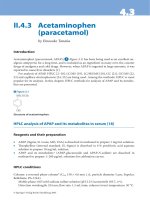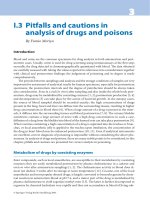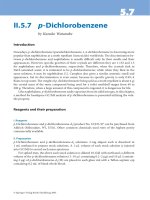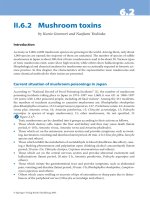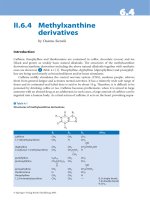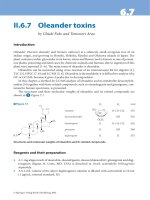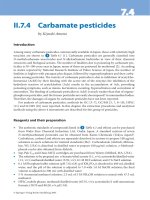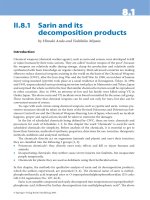Handbook of Adolescent Psychology, 2nd Edition docx
Bạn đang xem bản rút gọn của tài liệu. Xem và tải ngay bản đầy đủ của tài liệu tại đây (7.23 MB, 867 trang )
HANDBOOK OF
ADOLESCENT
PSYCHOLOGY
EDITED BY
RICHARD M. LERNER
LAURENCE STEINBERG
JOHN WILEY & SONS, INC.HANDBOOK OF
ADOLESCENT
PSYCHOLOGY
EDITED BY
RICHARD M. LERNER
LAURENCE STEINBERG
JOHN WILEY & SONS, INC.
This book is printed on acid-free paper. o
Copyright © 2004 by John Wiley & Sons, Inc. All rights reserved.
Published by John Wiley & Sons, Inc., Hoboken, New Jersey.
Published simultaneously in Canada.
No part of this publication may be reproduced, stored in a retrieval system, or transmitted in any form or
by any means, electronic, mechanical, photocopying, recording, scanning, or otherwise, except as
permitted under Section 107 or 108 of the 1976 United States Copyright Act, without either the prior
written permission of the Publisher, or authorization through payment of the appropriate per-copy fee to
the Copyright Clearance Center, Inc., 222 Rosewood Drive, Danvers, MA 01923, (978) 750-8400, fax (978)
646-8600, or on the web at www.copyright.com. Requests to the Publisher for permission should be
addressed to the Permissions Department, John Wiley & Sons, Inc., 111 River Street, Hoboken, NJ 07030,
(201) 748-6011, fax (201) 748-6008.
Limit of Liability/Disclaimer of Warranty: While the publisher and author have used their best efforts in
preparing this book, they make no representations or warranties with respect to the accuracy or
completeness of the contents of this book and specifically disclaim any implied warranties of
merchantability or fitness for a particular purpose. No warranty may be created or extended by sales
representatives or written sales materials. The advice and strategies contained herein may not be suitable
for your situation. You should consult with a professional where appropriate. Neither the publisher nor
author shall be liable for any loss of profit or any other commercial damages, including but not limited to
special, incidental, consequential, or other damages.
This publication is designed to provide accurate and authoritative information in regard to the subject
matter covered. It is sold with the understanding that the publisher is not engaged in rendering professional
services. If legal, accounting, medical, psychological or any other expert assistance is required, the services
of a competent professional person should be sought.
Designations used by companies to distinguish their products are often claimed as trademarks. In all
instances where John Wiley & Sons, Inc. is aware of a claim, the product names appear in initial capital or
all capital letters. Readers, however, should contact the appropriate companies for more complete
information regarding trademarks and registration.
For general information on our other products and services please contact our Customer Care Department
within the United States at (800) 762-2974, outside the United States at (317) 572-3993 or fax (317) 572-
4002.
Wiley also publishes its books in a variety of electronic formats. Some content that appears in print may
not be available in electronic books. For more information about Wiley products, visit our web site at
www.wiley.com.
Library of Congress Cataloging-in-Publication Data:
Lerner, Richard M.
Handbook of adolescent psychology / Richard M. Lerner and Laurence Steinberg.—2nd ed.
p. cm.
Includes bibliographical references and index.
ISBN 0-471-20948-1 (cloth)
1. Adolescent psychology. I. Steinberg, Laurence D., 1952– II. Title.
BF 724.L367 2004
155.5—dc21
2003049664
Printed in the United States of America.
10987654321
Contents
Contributors v
Foreword vii
Preface ix
1. The Scientific Study of Adolescent Development: Past, Present,
and Future 1
PART ONE FOUNDATIONS OF THE DEVELOPMENTAL
SCIENCE OF ADOLESCENCE
2. Puberty and Psychological Development 15
3. Cognitive and Brain Development 45
4. Socialization and Self-Development: Channeling, Selection,
Adjustment, and Reflection 85
5. Schools, Academic Motivation, and Stage-Environment Fit 125
6. Moral Cognitions and Prosocial Responding in Adolescence 155
7. Sex 189
8. Gender and Gender Role Development in Adolescence 233
9. Processes of Risk and Resilience During Adolescence: Linking
Contexts and Individuals 263
iii
PART TWO SOCIAL RELATIONSHIPS AND SOCIAL
CONTEXTS IN ADOLESCENCE
10. Adolescence Across Place and Time: Globalization and the
Changing Pathways to Adulthood 299
11. Parent-Adolescent Relationships and Influences 331
12. Adolescents’ Relationships with Peers 363
13. Contexts for Mentoring: Adolescent-Adult Relationships in
Workplaces and Communities 395
14. Work and Leisure in Adolescence 429
15. Diversity in Developmental Trajectories Across Adolescence:
Neighborhood Influences 451
16. Adolescents and Media 487
17. The Legal Regulation of Adolescence 523
PART THREE ADOLESCENT CHALLENGES, CHOICES,
AND POSITIVE YOUTH DEVELOPMENT
18. Adolescent Health from an International Perspective 553
19. Internalizing Problems During Adolescence 587
20. Conduct Disorder, Aggression, and Delinquency 627
21. Adolescent Substance Use 665
22. Adolescents with Developmental Disabilities and Their Families 697
23. Volunteerism, Leadership, Political Socialization, and Civic
Engagement 721
24. Applying Developmental Science: Methods, Visions, and Values 747
25. Youth Development, Developmental Assets, and Public Policy 781
Afterword: On the Future Development of Adolescent Psychology 815
Author Index 821
Subject Index 845
iv Contents
Contributors
v
Manuel Barrera, Jr.
Arizona State University
Peter L. Benson
Search Institute
Robert W. Blum
University of Minnesota
Jeanne Brooks-Gunn
Teachers College, Columbia University
B. Bradford Brown
University of Wisconsin-Madison
Nancy A. Busch-Rossnagel
Fordham University
Laurie Chassin
Arizona State University
W. Andrew Collins
University of Minnesota
Bruce E. Compas
Vanderbilt University
Lisa M. Diamond
University of Utah
Jacquelynne S. Eccles
University of Michigan
Nancy Eisenberg
Arizona State University
David P. Farrington
University of Cambridge
Thaddeus Ferber
Forum for Youth Investment
Celia B. Fisher
Fordham University
Constance A. Flanagan
Pennsylvania State University
Ulla G. Foehr
Stanford Unversity
Nancy L. Galambos
University of Alberta
Julia A. Graber
University of Florida
Beatrix Hamburg
Weill Medical College
David Hamburg
Carnegie Corporation of New York
Mary Agnes Hamilton
Cornell University
Steven F. Hamilton
Cornell University
Penny Hauser-Cram
Boston College
Lisa Henriksen
Stanford University School of Medicine
Andrea Hussong
University of North Carolina Chapel Hill
Daniel P. Keating
University of Toronto
Mary Wyngaarden Krauss
Brandeis University
Reed Larson
University of Illinois,
Urbana/Champaign
Brett Laursen
Florida Atlantic University
Richard M. Lerner
Tufts University
Tama Leventhal
Teachers College, Columbia University
Marc Mannes
Search Institute
Brooke S. G. Molina
University of Pittsburgh Medical Center
Amanda Sheffield Morris
University of New Orleans
Jeylan T. Mortimer
University of Minnesota
Kristin Nelson-Mmari
University of Minnesota
Jari-Erik Nurmi
University of Jyvaskyla
Karen Pittman
Forum for Youth Investment
Jennifer Ritter
Arizona State University
Donald F. Roberts
Stanford University
Alan Rogol
University of Virginia
Ritch C. Savin-Williams
Cornell University
Elizabeth S. Scott
University of Virginia
Lonnie R. Sherrod
Fordham University
Jeremy Staff
University of Minnesota
Laurence Steinberg
Temple University
Elizabeth J. Susman
The Pennsylvania State University
Ryan Trim
Arizona State University
Christopher Uggen
University of Minnesota
Suzanne Wilson
University of Illinois,
Urbana/Champaign
Jennifer L. Woolard
Georgetown University
vi Contributors
Foreword
Like snapshots of a growing family (and I use the metaphor “family” rather than
“child” because fields of study band together multiple personalities), subsequent edi-
tions of a scholarly handbook can reveal phenomenal changes. Imagine family photo-
graphs taken 25 years apart. You might hardly recognize the group as the same family.
In the case of adolescent study, the 25-year period between Handbook editions has
caused transformations every bit as consequential as those we would see in a human
family during a similar time span. From my reading of this splendid current Hand-
book, the changes have been entirely to the good.
As the editors correctly note, the term adolescence has been with us for centuries, but
the systematic examination of it for scientific purposes really began with G. Stanley
Hall in the early 1900s. Hall was a man of immense dedication to the healthy develop-
ment of young people. He convinced America to create playgrounds for its youth; he
helped build the new discipline of development psychology; and he trained many of
its early leaders. Yet Hall’s own pioneering writings on adolescence bent that young
branch in ways that would misdirect the field, and much of its public audience, for most
of the ensuing century.
Hall’s influences were 19th-century Bildungsromanen whose authors wrote romanti-
cally of youthful Sturm und Drang, a brilliant young “psych-analyist” Sigmund Freud
whom Hall introduced to America (and who had been reading those same German
novels), and trendy evolutionary theories that confused the ontogenesis of individuals
and species. The latter set of influences were so far-fetched and ultimately inflamma-
tory that scientists soon came to ignore this entire line in Hall’s writings. But his vision
of adolescence as a turbulent, trouble-ridden period that was at best a transition to
something saner—if the youngster did not first self-destruct—foreshadowed what was
to become the society’s dominant view of youths as walking problems. That vision was
to be elaborated in numerous ways beyond any imaginings that Hall could have had.
These ways led to ill-founded scientific studies as well as poor public policy advice.
The present Handbook is a world apart, for reasons both sensible and profound. For
one thing, it is refreshing to read a collection of studies portraying adolescence as a full-
colored, rich experience in itself, rather than only as a transition toward something or
away from something. There are many highpoints in the collective portrayal of youth
embodied in this Handbook, and I do not mean to slight any of them by mentioning
others, but I was especially struck by the lush array of interests, capacities, and mean-
ingful youthful activities that emerges from many of the chapters in this handbook.
From the cognitive to the moral, from the academic to the civic, in relations with peers,
parents, and society on its most global level, adolescents in this Handbook are shown
vii
as active and able players in the world. They are not seen as unwitting pawns of their
own uncontrollable desires or helpless victims of external forces beyond their control.
The young people in this Handbook reason powerfully; make their own choices about
their social and sexual relationships; adapt to their schools in a manner consistent with
their own motives and concerns; navigate the complexity of influences that they en-
counter in their families, neighborhoods, mass media, and legal system; and end up
forging their own judgments about who they are and what they believe in. Sometimes
their judgments work for the better, sometimes for the worse. There are real risks and
casualties associated with this age period, and the Handbook examines several of the
most prominent ones. This we have long known. But there is also an infinite promise
and positive excitement associated with youth. This, too, has long been known but per-
haps was put out of mind too often in our initial century of adolescent research. The
current Handbook merits our thanks for bringing the more positive, and accurate,
characterization back to the fore.
A few years ago, the Society of Research in Adolescence indulged itself by arrang-
ing its biennial conference in sunny San Diego. An effect of the climate was that, at any
time during the conference, large numbers of prominent adolescent researchers could
be found seated around the hotel swimming pool. Perhaps as an excuse to hang out
there myself—but also, I must admit, due to my sincere puzzlement about the matter—
I took the opportunity to conduct an informal survey on the following question: What
is adolescence?
Notably, none of the 20-or-so researchers whom I collared settled upon a demar-
cated age period (say, “twixt twelve and twenty”) as their final answer. (Here I should
probably tweak the present editors for their designation of “the second decade of life”
in their Preface, although I am sure that this was not meant to be their considered
scientific definition of the term.) Intead, the answers noted benchmark experiences
that bounded the period in a developmental sense. The designated benchmarks varied
among researchers, but there were commonalities in the responses. Most common of
the initiating benchmarks was puberty. The closing benchmark was harder to capture
in a word or phrase: it was experiential in nature, and it often touched on the Erikson-
ian notion of psychosocial identity—my own translation would be something like “a
stable personal commitment to an adult role.” Now I do not believe that this amal-
gam—the period between the advent of puberty and a stable commitment to an adult
role—would hold up long as a scientific definition, at least without lots of further def-
initional work on both ends. Yet it is not a bad place to start, and I have found myself
using it in public lectures whenever anyone puts to me the pesky question of “What is
adolescence?”
I mention this here because puberty is exactly where the substantive set of chapters
in this Handbook begins, and the acquisition of social roles in its most important
sense—citizenship and civic engagement—is about where the book ends. In between,
we have the whole glorious parade of exploration and growth, challenge and struggle,
risk and progress. It is another indicator to me of this Handbook’s validity—and its
value to anyone who wishes to gain a deeper understanding of this most memorable
and formative period of live.
William Damon
viii Foreword
Preface
According to most social scientists, a generation is about 25 years in length. By that
measure, this second edition of the Handbook of Adolescent Psychology represents a
generational shift, for it was fully 25 years ago that the first edition of this volume was
published. A cursory glance at this edition’s table of contents will show just how broadly
the field has grown in that period of time, and a careful reading of the volume’s chap-
ters will reveal that the generational shift has been as deep as it has been broad.
When the first edition of the Handbook was published in 1980, the empirical study
of adolescence, by our calculation, was barely 5 years old. Much of what was prepared
for that Handbook was, of necessity, theoretical because there was very little empirical
work on which contributors could draw. In addition, much of the theorizing was psy-
choanalytic in nature, because through the mid-1970s that had been the dominant
worldview among those who thought about adolescence. Now, it is fair to say that the
field has reached full maturity, or at least a level of maturity comparable to that found
in the study of any other period of development. Indeed, as we note in the first chapter
of the volume, in which we review and reflect on the development of the scientific study
of adolescence, research on the second decade of life often serves as a model for re-
search on other stages of development. As the contributions to this volume clearly il-
lustrate, the science of adolescent psychology is sophisticated, interdisciplinary, and
empirically rigorous. Interestingly enough, grand theories of adolescence, whether
psychoanalytic or not, have waned considerably in their influence.
Other generational changes can also be discerned by comparing the second and first
editions of the Handbook. First, the study of adolescent difficulty and disturbance has
taken a backseat to the study of processes of normative development. Accordingly, al-
though the current edition includes several chapters on the development of psycholog-
ical problems in adolescence, they by no means dominate the volume’s contents. Sec-
ond, our knowledge about the ways in which processes of adolescent development are
shaped by interacting and embedded systems of proximal and distal contextual forces
has made the study of adolescence less purely psychological in nature and far more in-
terdisciplinary. While psychology continues to be the primary discipline reflected in the
contents (and, of course, the title) of this Handbook, it is not the only one. Contribu-
tors to the volume have drawn on a wide array of disciplines, including sociology, biol-
ogy, education, neuroscience, and law. Third, the growth in applied developmental
science over the past decade has led to a more explicit focus on the ways in which em-
pirically based knowledge about adolescence can be used to promote positive youth de-
velopment. Several contributions to this volume reflect this emphasis.
This edition of the Handbook of Adolescent Psychology is concerned with all aspects
ix
of development during the second decade of life, with all the contexts in which this de-
velopment takes place and with a wide array of social implications and applications of
the scientific knowledge gained through empirical research. This edition is divided into
three broad sections: foundations of adolescent development, the contexts of adoles-
cent development, and special challenges and opportunities that arise at adolescence.
These sections are preceded by a foreword (by William Damon) and followed by an af-
terword (by Beatrix and David Hamburg), which locate the Handbook’s contribution
within the history of the field of adolescent development.
The first section of the Handbook examines the foundations of the scientific study
of individual development in adolescence. Following an introductory chapter that
overviews the past history and future prospects of adolescent psychology as a scientific
enterprise (Lerner and Steinberg), contributions in this section examine puberty and its
impact on psychological development (Susman and Rogol), cognitive and brain de-
velopment (Keating), the development of the self (Nurmi), academic motivation and
achievement in school settings (Eccles), morality and prosocial development (Eisenberg
and Morris), sexuality and sexual relationships (Savin-Williams and Diamond), gender
and gender role development (Galambos), and processes of risk and resilience (Com-
pas). Taken together, these chapters illustrate the ways in which biological, intellectual,
emotional, and social development unfold and interact during the second decade of the
life span.
The second section focuses on the immediate and broader contexts in which adoles-
cent development takes place. The chapters in this section situate adolescent develop-
ment across history, cultures, and regions of the world (Larson and Wilson); within
the family, and especially in the context of the parent-child relationship (Collins and
Laursen); within the interconnected and nested contexts of peer relationships, includ-
ing friendships, romantic relationships, adversarial relationships, cliques, and crowds
(Brown); in relationships with adult mentors at work and in the community (Hamilton
and Hamilton); in the settings of work and leisure (Staff, Mortimer, and Uggen); in neigh-
borhood contexts (Leventhal and Brooks-Gunn); within the contexts defined by mass
media and technology (Roberts, Henriksen, and Foehr); and within the law (Scott and
Woolard). Consistent with the ecological perspective on human development that has
dominated research on adolescence for the past two decades, these contributions show
how variations in proximal, community, and distal contexts profoundly shape and alter
the developmental processes, trajectories, and outcomes associated with adolescence.
The final section of the Handbook examines a variety of challenges and opportuni-
ties that can threaten or facilitate healthy development in adolescence and explores the
ways in which maladaptive as well as positive trajectories of youth development unfold.
The first set of contributions in this section considers threats to the well-being of ado-
lescents, including physical illness, examined from an international perspective (Blum
and Nelson-Mmari); internalizing problems, including depression, anxiety, and disor-
dered eating (Graber); externalizing problems, including conduct disorder, aggression,
and delinquency (Farrington); substance use and abuse, including the use and abuse of
tobacco, alcohol, and other drugs (Chassin, Hussong, Barrera, Molina, Trim, and Rit-
ter); and developmental disabilities, including autism, cerebral palsy, epilepsy, mental
retardation, and other neurological impairments (Hauser-Cram and Krauss). The sec-
ond set of contributions in this concluding section examines three sorts of opportuni-
x Preface
ties with the potential to promote health and well-being in adolescence: the promotion
of volunteerism and civic engagement among youth (Flanagan); the application of de-
velopmental science to facilitate healthy adolescent development (Sherrod, Busch-
Rossnagel, and Fisher); and the development of policies and programs explicitly de-
signed to promote positive youth development (Benson, Mannes, Pittman, and Ferber).
There are numerous people to thank for their important contributions to the Hand-
book. First and foremost, we owe our greatest debt of gratitude to the colleagues who
wrote the chapters, foreword, and afterword for the Handbook. Their scholarly excel-
lence and leadership and their commitment to the field are the key assets for any con-
tributions that this Handbook will make both to the scientific study of adolescence and
to the application of knowledge that is requisite for enhancing the lives of diverse young
people worldwide.
We appreciate as well the important support and guidance provided to us by the
members of the editorial board for the Handbook. We thank Peter L. Benson, Dale A.
Blyth, Jeanne Brooks-Gunn, B. Bradford Brown, W. Andrew Collins, William Damon,
Jacquelynne Eccles, David Elkind, Nancy Galambos, Robert C. Granger, Beatrix
Hamburg, Stuart Hauser, E. Mavis Hetherington, Reed Larson, Jacqueline V. Lerner,
David Magnusson, Anne C. Petersen, Diane Scott-Jones, Lonnie R. Sherrod, Margaret
Beale Spencer, and Wendy Wheeler for their invaluable contributions.
We are very grateful to Karyn Lu, managing editor in the Applied Developmental
Science Institute in the Eliot-Pearson Department of Child Development at Tufts Uni-
versity. Her impressive ability to track and coordinate the myriad editorial tasks asso-
ciated with a project of this scope, her astute editorial skills and wisdom, and her never-
diminishing good humor and positive attitude were invaluable resources throughout
our work.
We are also appreciative of our publishers and editors at John Wiley & Sons: Peggy
Alexander, Jennifer Simon, and Isabel Pratt. Their enthusiasm for our vision for the
Handbook, their unflagging support, and their collegial and collaborative approach to
the development of this project were vital bases for the successful completion of the
Handbook.
We also want to express our gratitude to the several organizations that supported
our scholarship during the time we worked on the Handbook. Tufts University and
Temple University provided the support and resources necessary to undertake and
complete a project like this. In addition, Richard M. Lerner thanks the National 4-H
Council, the William T. Grant Foundation, and the Jacobs Foundation, and Laurence
Steinberg thanks the John D. and Catherine T. MacArthur Foundation, for their gen-
erous support.
Finally, we want to dedicate this Handbook to our greatest sources of inspiration,
both for our work on the Handbook and for our scholarship in the field of adolescence:
our children, Blair, Jarrett, Justin, and Ben. Now all in their young adulthood, they
have taught us our greatest lessons about the nature and potentials of adolescent de-
velopment.
R.M.L.
L.S.
March 2003
Preface xi
THE SCIENTIFIC STUDY OF
ADOLESCENT DEVELOPMENT
Past, Present, and Future
Richard M. Lerner and Laurence Steinberg
1
In the opening sentence of the preface to the first edition of his classic A History of Ex-
perimental Psychology, Edwin G. Boring (1929) reminded readers that “psychology has
a long past, but only a short history” (p. ix), a remark he attributed to the pioneer of
memory research, Hermann Ebbinghaus. A similar statement may be made about the
study of adolescents and their development.
The first use of the term adolescence appeared in the 15th century. The term was a
derivative of the Latin word adolescere, which means to grow up or to grow into matu-
rity (Muuss, 1990). However, more than 1,500 years before this first explicit use of the
term both Plato and Aristotle proposed sequential demarcations of the life span, and
Aristotle in particular proposed stages of life that are not too dissimilar from sequences
that might be included in contemporary models of youth development. He described
three successive, 7-year periods (infancy, boyhood, and young manhood) prior to the
person’s attainment of full, adult maturity. About 2,000 years elapsed between these ini-
tial philosophical discussions of adolescence and the emergence, within the 20th cen-
tury, of the scientific study of the second decade of life.
The history of the scientific study of adolescence has had two overlapping phases
and is, we believe, on the cusp of a third. The first phase, which lasted about 70 years,
was characterized by three sorts of Cartesian splits (see Overton, 1998) that created
false dichotomies that in turn limited the intellectual development of the field. With re-
spect to the first of these polarizations, “grand” models of adolescence that purport-
edly pertained to all facets of behavior and development predominated (e.g., Erikson,
1959, 1968; Hall, 1904), but these theories were limited because they were either largely
all nature (e.g., genetic or maturational; e.g., Freud, 1969; Hall, 1904) or all nurture
(e.g., McCandless, 1961). Second, the major empirical studies of adolescence during
this period were not primarily theory-driven, hypothesis-testing investigations but were
atheoretical, descriptive studies; as such, theory and research were split into separate
enterprises (McCandless, 1970). Third, there was a split between scholars whose work
was focused on basic developmental processes and practitioners whose focus was on
community-based efforts to facilitate the healthy development of adolescents.
The second phase in the scientific study of adolescence arose in the early- to mid-
1970s as developmental scientists began to make use of research on adolescents in elu-
cidating developmental issues of interest across the entire life span (Petersen, 1988). At
the beginning of the 1970s, the study of adolescence, like the comedian Rodney Dan-
gerfield, “got no respect.” Gradually, however, research on adolescent development be-
gan to emerge as a dominant force in developmental science. By the end of the 1970s
the study of adolescence had finally come of age.
To help place this turning point in the context of the actual lives of the scientists in-
volved in these events, it may be useful to note that the professional careers of the edi-
tors of this Handbook began just as this transition was beginning to take place. Across
our own professional lifetimes, then, the editors of this volume have witnessed a sea
change in scholarly regard for the study of adolescent development. Among those
scholars whose own careers have begun more recently, the magnitude of this transfor-
mation is probably hard to grasp. To those of us with gray hair, however, the change has
been nothing short of astounding. At the beginning of our careers, adolescent devel-
opment was a minor topic within developmental science, one that was of a level of im-
portance to merit only the publication of an occasional research article within prime
developmental journals or minimal representation on the program of major scientific
meetings. Now, three decades later, the study of adolescent development is a distinct
and major field within developmental science, one that plays a central role in inform-
ing, and, through vibrant collaborations with scholars having other scientific special-
ties, being informed by, other areas of focus.
The emergence of this second phase of the study of adolescence was predicated in
part on theoretical interest in healing the Cartesian splits (Overton, 1998) characteris-
tic of the first phase and, as such, in exploring and elaborating developmental models
that reject reductionist biological or environmental accounts of development and in-
stead focus on the fused levels of organization constituting the developmental system
and its multilayered context (e.g., Sameroff, 1983; Thelen & Smith, 1998). These devel-
opmental systems models have provided a metatheory for adolescent developmental
research and have been associated with more midlevel (as opposed to grand) theories—
models that have been generated to account for person-environment relations within
selected domains of development.
Instances of such midlevel developmental systems theories are the stage-environment
fit model used to understand achievement in classroom settings (Eccles, Wigfield, &
Byrnes, 2003), the goodness of fit model used to understand the relation of tempera-
mental individuality in peer and family relations (Lerner, Anderson, Balsano, Dowling,
& Bobek, 2003), and models linking the developmental assets of youth and communi-
ties in order to understand positive youth development (Benson, 1997; Damon, 1997).
For instance, Damon (1997; Damon & Gregory, 2003) forwarded a new vision and vo-
cabulary about adolescents that was based on their strengths and potential for positive
development. Damon explained that such potential could be instantiated by building
new youth-community relationships predicated on the creation of youth charters, agree-
ments that codified community-specific visions and action agendas for promoting pos-
itive life experiences for adolescents.
Generally speaking, the study of adolescence in its second phase was characterized
by an interest in developmental plasticity, in diversity, and in the application of science
to real-world problems. This phase also was marked by the development and use of
2 The Scientific Study of Adolescent Development
more nuanced and powerful developmental methods aimed at providing sensitivity to
the collection and analysis of longitudinal data pertinent to the multiple levels.
More than a quarter century ago, Bronfenbrenner (1974) explained the importance
of a science of development that involved the full and bidirectional collaboration be-
tween the producers and consumers of scientific knowledge. In turn, D. A. Hamburg
(1992; D. A. Hamburg & Takanishi, 1996) proposed that the quality of life of adoles-
cents, and their future contributions to civil society, could be enhanced through col-
laboration among scholars, policy makers, and key social institutions, for instance,
community-based youth-serving organizations (e.g., 4-H, Boys and Girls Clubs, scout-
ing), schools, and the media. In our view, D. A. Hamburg’s (1992; D. A. Hamburg &
Takanishi, 1996) vision has been actualized. We are now at the cusp of the emergence
of a third phase in the history of the scientific study of adolescence, one that we hope
will be marked by the publication of this Handbook. This phase involves the emergence
of the field of adolescent development as an exemplar of the sort of developmental sci-
ence that can be used by policy makers and practitioners in order to advance civil soci-
ety and promote positive development (Lerner, Fisher, & Weinberg, 2000). The con-
tributors to this volume provide much evidence that the field of adolescence may be
entering a phase of its development wherein such a scientist–policy maker–practitioner
collaboration may be a central, organizing frame.
THE FIRST PHASE OF THE SCIENTIFIC STUDY OF ADOLESCENCE
In 1904 G. Stanley Hall, with the publication of his two-volume work Adolescence, ini-
tiated the scientific study of adolescence. He launched the field as one steeped in a split
and nativist view of development, one that was and linked to a biologically based,
deficit view of adolescence.
Fancying himself as the “Darwin of the mind” (White, 1968), Hall sought to trans-
late the ideas of Ernst Haeckel (e.g., 1868, 1891), an early contributor to embryology,
into a theory of life span human development. Haeckel advanced the idea of recapitu-
lation: The adult stages of the ancestors comprising a species’ evolutionary (phyloge-
netic) history were repeated in compressed form as the embryonic stages of the organ-
ism’s ontogeny. Hall extended Haeckel’s idea of recapitulation beyond the prenatal
period in order to fashion a theory of human behavioral development. To Hall, ado-
lescence represented a phylogenetic period when human ancestors went from being
beastlike to being civilized. Hall (1904) saw adolescence as a period of storm and stress,
as a time of universal and inevitable upheaval.
Although other scholars of this period (e.g., Thorndike, 1904) quickly rejected Hall’s
recapitulationism on both empirical and methodological grounds (e.g., see Lerner,
2002, for a discussion), other theorists of adolescent development used a conceptual
lens comparable to Hall’s, at least insofar as his biological reductionism and his deficit
view of adolescence were concerned. Anna Freud (1969), for instance, saw adolescence
as a biologically based and universal developmental disturbance. Erik Erikson (1950,
1959) viewed the period as one in which an inherited maturational ground plan resulted
in the inescapable psychosocial crisis of identity versus role confusion. Even when the-
The First Phase of the Scientific Study of Adolescence 3
orists rejected the nature-based ideas of psychoanalysts or neopsychoanalysts, they
proposed nurture-oriented ideas to explain the same problems of developmental dis-
turbance and crisis. For example, McCandless (1961, 1970) presented a social-learning,
drive-reduction theory to account for the developmental phenomena of adolescence
(e.g., regarding sex differences in identity development) that Erikson (1959) interpreted
as being associated with maturation (see Lerner & Spanier, 1980, for a discussion).
Although the developmental theory of cognition proposed by Piaget (1960, 1969,
1970, 1972) involved a more integrative view of nature and nurture than did these other
models, the predominant focus of his ideas was on the emergence of formal logical
structures and not on the adolescent period per se. The absence of concern in Piaget’s
theory with the broader array of biological, emotional, personality, social, and societal
concerns that had engaged other theorists’ discussions of adolescence did not stop a
relatively minor and historically transitory interest in Piaget’s ideas as a frame for em-
pirical understanding of the adolescent period (Steinberg & Morris, 2001). However, as
Steinberg and Morris explained, only a short while after this period of heightened in-
terest in using the onset of formal operations as an explanation for everything adoles-
cent, the influence of Piaget’s theory on mainstream empirical work in the study of ado-
lescence would become as modest as that associated with the other grand theories of
the period, such as those authored by Erikson or McCandless.
The divergence between the so-called grand theories of the adolescent period and
the range of research about adolescence that would come to characterize the field at the
end of the 20th century actually existed for much of the first phase of the field’s devel-
opment. The classic studies of adolescence conducted between 1950 and 1980 were not
investigations derived from the theories of Hall, Anna Freud, McCandless, Piaget, or
even Erikson (work associated with the ideas of Marcia, 1980, notwithstanding). In-
stead, this research was directed to describing (note, not explaining; McCandless, 1970;
Petersen, 1988) patterns of covariation among pubertal timing, personal adjustment,
and relationships with peers and parents (e.g., Jones & Bayley, 1950; Mussen & Jones,
1957), both within and across cultural settings (e.g., Mussen & Bouterline Young, 1964);
the diversity in trajectories of psychological development across adolescence (e.g.,
Bandura, 1964; Block, 1971; Douvan & Adelson, 1966; Offer, 1969); and the influence
of history or temporality (i.e., as operationalized by time of testing- or cohort-related
variation) on personality development, achievement, and family relations (e.g., Elder,
1974; Nesselroade & Baltes, 1974). Petersen (1988, p. 584) described the quality of the
classic empirical work on adolescence by noting that most “research fell into one of two
categories: (a) studies on behavioral or psychological processes that happened to use
adolescent subjects, or (b) descriptive accounts of particular groups of adolescents,
such as high school students or delinquents.”
Despite its separation from the grand theories of adolescence that dominated the
field during its first phase of scientific development, this body of early research, as well
as the subsequent scholarship it elicited (e.g., see reviews by Lerner & Galambos,
1998; Petersen, 1988; Steinberg & Morris, 2001), made several important contributions
to shaping the specific character of the scientific study of adolescence between the
early-1980s and late-1990s. As elaborated later, this character involved the longitudinal
study of individual-context relations among diverse groups of youth and the use of such
scholarship for purposes of both elucidating basic developmental processes and apply-
4 The Scientific Study of Adolescent Development
ing developmental science to promote positive youth development (B. Hamburg, 1974;
Lerner, 2002).
These contributions also advanced the study of adolescence because scholarship
about the second decade of life acted synergistically with broader scholarly activity
within developmental science pertinent to the theoretical, methodological, and applied
features of the study of human development across the life span. For instance, a classic
paper by B. Hamburg (1974) did much to provide the foundation for this integration,
in that it made a compelling case for viewing the early adolescent period as a distinct
period of the life course and one that provided an exemplary ontogenetic window for
understanding key person-context processes involved in coping and adaptation. Based
on such evidence, Petersen (1988, p. 584) noted,
Basic theoretical and empirical advances in several areas have permitted the advance of re-
search on adolescence. Some areas of behavioral science from which adolescence re-
searchers have drawn are life-span developmental psychology, life-course sociology, social
support, stress and coping, and cognitive development; important contributing areas in
the biomedical sciences include endocrinology and adolescent medicine. The recent mat-
uration to adolescence of subjects in major longitudinal studies . . . has also contributed
to the topic’s empirical knowledge base.
The emergence of the relationship between the specific study of adolescence and more
general scholarship about the overall course of human development provided the bridge
to the second phase in the study of adolescent development. Indeed, about a decade af-
ter this second phase had begun, Petersen (1988, p. 601) predicted, “Current research
on adolescence will not only aid scientific understanding of this particular phase of life,
it also may illuminate development more generally.” Future events were consistent with
Petersen’s prognostication.
THE SECOND PHASE OF THE SCIENTIFIC STUDY OF ADOLESCENCE
From the late 1970s through this writing the adolescent period has come to be regarded
as an ideal natural ontogenetic laboratory for studying key theoretical and methodolog-
ical issues in developmental science (Lerner, 2002; Steinberg & Morris, 2001). There are
several reasons for the special salience of the study of adolescent development to un-
derstanding the broader course of life span development. First, although the prenatal
and infant period exceeds adolescence as an ontogenetic stage of rapid physical and
physiological growth, the years from approximately 10 to 20 not only include the con-
siderable physical and physiological changes associated with puberty but also mark a
time when the interdependency of biology and context in human development is read-
ily apparent (Susman & Rogol, this volume). Second, as compared to infants, the cog-
nizing, goal-setting, and relatively autonomous adolescent can, through reciprocal rela-
tions with his or her ecology, serve as an active influence on his or her own development,
and the study of adolescence can inform these sorts of processes more generally
(Lerner, 2002). Third, the multiple individual and contextual transitions into, through-
out, and out of this period, involving the major institutions of society (family, peers,
The Second Phase of the Scientific Study of Adolescence 5
schools, and the workplace), engage scholars interested in broader as well as individual
levels of organization and also provide a rich opportunity for understanding the nature
of multilevel systemic change. Finally, there was also a practical reason for the growing
importance of adolescence in the broader field of developmental science: As noted by
Steinberg and Morris (2001), the longitudinal samples of many developmental scien-
tists who had been studying infancy or childhood had aged into adolescence. Applied
developmental scientists were also drawn to the study of adolescents, not just because
of the historically unprecedented sets of challenges to the healthy development of ado-
lescents that arose during the latter decades of the 20th century (Dryfoos, 1990; Lerner,
1995) but also because interest in age groups other than adolescents nevertheless fre-
quently involved this age group (e.g., interest in infants often entailed the study of
teenage mothers, and interest in middle and old age frequently entailed the study of the
“middle generation squeeze,” wherein the adult children of aged parents cared for their
own parents while simultaneously raising their own adolescent children).
The Emerging Structure of the Field of Adolescent Development
This scholarly activity at the close of the 1970s was both a product and a producer of a
burgeoning network of scholars from multiple disciplines. In 1981 the late Herschel
Thornburg launched a series of biennial meetings (called the Conference on Adoles-
cent Research) at the University of Arizona. During these meetings (which occurred
also in 1983 and 1985), the idea for a new scholarly society, the Society for Research on
Adolescence (SRA), was born. The first meeting of SRA was held in Madison, Wiscon-
sin, in 1986, and Thornburg was elected the first president of the organization. Across
the next two decades, with biennial conventions in Alexandria, Virginia (1988), Atlanta
(1990), Washington (1992), San Diego (1994), Boston (1996), again in San Diego (1998),
Chicago (2000), New Orleans (2002), and Baltimore (2004), and through the leadership
of the SRA presidents who succeeded Thornburg—John P. Hill, Anne C. Petersen,
E. Mavis Hetherington, Sanford M. Dornbusch, Jeanne Brooks-Gunn, Stuart T. Hauser,
Laurence Steinberg, W. Andrew Collins, Jacquelynne Eccles, and Elizabeth Susman—
the organization and the field it represented flourished. Between 1986 and 2002, atten-
dance at SRA biennial meetings more than quadrupled. The SRA launched its own
scholarly journal in 1991, the Journal of Research on Adolescence (Lerner, 1991); grew
from approximately 400 members in 1986 to more than 1,200 members in 2002; and
attracted disciplinary representation from scholars and practitioners with expertise
in psychology, sociology, education, family studies, social work, medicine, psychiatry,
criminology, and nursing.
Impetus to this growth in scholarly interest in the study of adolescence also was stim-
ulated by the publication in 1980 of the first handbook for the field. Edited by Joseph
Adelson (1980), the Handbook of Adolescent Psychology was published as part of the
Wiley series on personality processes. The volume reflected the emerging multidiscipli-
nary interest in the field (with chapters discussing levels of organization ranging from
biology through history, including an interesting historical chapter on youth move-
ments), the growing interest in systems models of adolescent development (e.g., in the
chapters by Elder, 1980, and by Petersen & Taylor, 1980), the importance of longitudi-
6 The Scientific Study of Adolescent Development
nal methodology (Livson & Peskin, 1980), and the increasing interest in diversity (i.e.,
there was a five-chapter section titled “Variations in Adolescence”). It is important to
note that through several chapters pertinent to the problems of adolescence there was
still ample representation in the volume of the deficit view of adolescence. Nevertheless,
the 1980 Handbook included information pertinent to normative development and de-
velopmental plasticity, and several chapters discussed the positive individual and social
features of youth development.
The publication of a handbook, the organization of a successful scholarly society,
and the initiation of that society’s scholarly journal all underscored the growing inter-
est in and the scientific maturity of research on adolescent development. This intel-
lectual milieu and the scholarly opportunities it provided attracted a broad range of
scholars to the field, some for reasons that had little to do with adolescence per se, but
others because they came to see themselves as experts on the second decade of life. By
the mid-1980s a growing cadre of scientists would identify themselves as adolescent
developmentalists.
The Study of Adolescence as a Sample Case for Understanding Plasticity and
Diversity in Development
Scholars interested primarily in the instantiation of developmental processes within
other periods of the life span (e.g., infancy, Easterbrooks & Graham, 1999; adult de-
velopment and aging, Brim, 1966; Nesselroade & Baltes, 1974) or in disciplines other
than developmental psychology (e.g., life course sociology; Burton, 1990; Elder, 1974,
1980) became adolescent developmentalists as well. This attraction inheres in the
window that the period provides to understanding how development at any point
across the life span involves the relations of diverse and active individuals and diverse,
active, and multitiered ecologies (Bronfenbrenner, 1979; Bronfenbrenner & Morris,
1998; Lerner, 2002).
As suggested by Steinberg and Morris (2001), the scientific concern that arguably
was most significant in transforming the field of adolescent development beyond a fo-
cus on this single developmental period into an exemplar for understanding the breadth
of the human life span was the emerging focus within developmental science on the
ecology of human development (e.g., Bronfenbrenner, 1979, 2001; Bronfenbrenner &
Morris, 1998). The integrated designed and natural ecology was of interest because its
study was regarded as holding the key to (a) understanding the system of relations be-
tween individuals and contexts that is at the core of the study of human development and
(b) providing evidence that theories about the character of interacting developmental
system (e.g., Collins, Maccoby, Steinberg, Hetherington, & Bornstein, 2000; Gottlieb,
1997, 1998; Horowitz, 2000; Thelen & Smith, 1998) are more useful in accounting for
the variance in human ontogeny than are theories whose grounding is either exclusively
in nature (e.g., behavioral genetic or sociobiological; e.g., Plomin, 2000; Rowe, 1994;
Rushton, 2000) or exclusively in nurture (e.g., social learning or functional analysis;
Gewirtz & Stingle, 1968; McCandless, 1970).
A second set of broader issues that engaged developmental science in the study of
adolescence pertained to understanding the bases, parameters, and limits of the plas-
The Second Phase of the Scientific Study of Adolescence 7
ticity of human development. As implied earlier, this plasticity legitimated an optimistic
view about the potential for interventions into the course of life to enhance human de-
velopment, encouraged growth in scientific activity in the application of developmental
science to improve life outcomes, and gave impetus to the idea that positive develop-
ment could be promoted among all people (Lerner, Fisher, & Weinberg, 2000). More-
over, plasticity meant that the particular instances of human development found within
a given sample or period of time were not necessarily representative of the diversity of
development that might potentially be observed under different conditions.
Third, developmentalists pursuing an interest in the developmental system and the
plasticity in ontogenetic change that it promoted recognized the need to develop and
deploy methods that could simultaneously study changes in (at least a subset of ) the
multiple levels of organization involved in the development of diverse individuals and
contexts. Accordingly, multivariate longitudinal designs were promoted as key to the
study of the relatively plastic developmental system, as were the development of em-
pirical tools, such as change-sensitive measures, sophisticated data analysis techniques,
and strategies such as triangulation of observations within and across both quantita-
tive and qualitative domains of inquiry.
Defining Features of the Study of Adolescence During Its Second Phase
Four defining features of the second phase of the science of adolescent development are
worth noting. First, during its second phase of life, the empirical study of adolescence
emerged as a relational field of inquiry. That is, it became an area of scholarship in
which implicitly (e.g., Block, 1971; Mussen & Bouterline-Young, 1964) or, at times, ex-
plicitly (e.g., Nesselroade & Baltes, 1974) the key unit of analysis in understanding the
development of the person was his or her relation with both more molecular (e.g., bio-
logical) and more molar (social group, cultural, and historical) levels of organization
(Overton, 1998). In such a relational frame, no one level of organization was seen as the
prime mover of development.
A second distinctive feature of the field of adolescence within this second phase de-
rived from its relational character. The confluence of the multiple levels of organization
involved in the developmental system provides the structural and functional bases of
plasticity and of the inevitable and substantively significant emergence of systematic in-
dividual differences; that is, such individuality serves as a key basis of the person’s abil-
ity to act as an agent in his or her own development (Brandtstädter, 1998; Lerner, 2002).
Accordingly, the field of adolescence has become the exemplar within the broader study
of human development for the substantive study of diversity and for the person-centered
approach to research on human development (Magnusson, 1999a, 1999b; Magnusson
& Stattin, 1998).
Third, although there remains a focus within the contemporary adolescent literature
on problems of this developmental period (Steinberg & Morris, 2001), the focus on
plasticity, diversity of development and people, and individual agency—and thus the
strength or capacity of an adolescent to influence his or her development for better or
for worse—means that problematic outcomes of adolescent development are now just
one of a larger array of outcomes that may characterize the relatively plastic relations
between adolescents and their contexts (e.g., B. Hamburg, 1974; D. A. Hamburg, 1992).
8 The Scientific Study of Adolescent Development
Indeed, this plasticity provides the theoretical basis of the view that all young people
possess strengths, or, more simply, the potential for positive development (Damon,
1997; Damon & Gregory, 2003).
The idea that the adolescent period provides the ideal time within life to study the
bases of positive human development frames what has become a fourth defining fea-
ture of the field. The study of adolescent development is now characterized by a syn-
thetic interest in basic and applied concerns about youth development. One’s basic un-
derstanding of how relational processes within the developmental system provide a
basis for diverse developmental trajectories across adolescence can be tested by assess-
ing whether changes in individual and ecological variables within the system combine
to actualize the strengths of youth. Benson (1990, 1997; Benson, Mannes, Pittman, &
Ferber, this volume) termed these individual and ecological variables developmental as-
sets. Such tests of developmental theory, when implemented within the actual ecology
of human development, are interventions into the course of adolescent development.
Depending on their target level of organization, these actions constitute policies or pro-
grams, and in this context basic research in adolescence is also applied developmental
science (Bronfenbrenner & Morris, 1998; Lerner, 2002). As a consequence of this trend,
the field has come to place a premium on community-based, change-oriented methods,
both to study development and to evaluate the efficacy of programs and policies de-
signed to alter the course of adolescent life for the better.
CONCLUSIONS: ADOLESCENCE AS A FIELD OF SCIENTIST–
PRACTITIONER–POLICY MAKER COLLABORATION
The chapters in this Handbook both reflect and extend the emphases on individual-
context relations, developmental systems, plasticity, diversity, longitudinal methodol-
ogy, and application that were crystallized and integrated within the second phase of
the development of the scientific study of adolescence. As evident within each of the
chapters in this Handbook, and as underscored in both the foreword and the afterword
to the volume, the study of adolescence today represents the exemplar within develop-
mental science wherein excellent conceptual and empirical work is undertaken with a
collaborative orientation to making a contribution both to scholarship and to society.
Arguably more so than in scholarship pertinent to other periods across the life span,
within the study of adolescence the vision of Bronfenbrenner (1974) and D. A. Ham-
burg (1992; D. A. Hamburg & Takanishi, 1996) of a developmental science involving
reciprocal collaborations among researchers, practitioners, and policy makers is being
actively pursued, if not yet completely realized.
The future of civil society in the world rests on the young. Adolescents represent at
any point in history the generational cohort that must next be prepared to assume the
quality of leadership of self, family, community, and society that will maintain and im-
prove human life. Scientists have a vital role to play to make in enhancing, through the
generation of basic and applied knowledge, the probability that adolescents will be-
come fully engaged citizens who are capable of, and committed to, making these con-
tributions. The chapters in this Handbook demonstrate that high-quality scientific
work on adolescence is in fact being generated at levels of study ranging from the bio-
Conclusions: Adolescence as a Field of Scientist–Practitioner–Policy Maker Collaboration 9
logical through the historical and sociocultural. Above all, this volume demonstrates
that the study of adolescent development at its best both informs and is informed by the
concerns of communities, practitioners, and policy makers. It is our hope that we have
assembled the best information possible to be used to promote and advocate for the
healthy and positive development of young people everywhere.
REFERENCES
Adelson, J. (Ed.). (1980). Handbook of adolescent psychology. New York: Wiley.
Bandura, A. (1964). The stormy decade: Fact or fiction? Psychology in the School, 1, 224–231.
Benson, P. L. (1990). The troubled journey: A portrait of 6th–12th grade youth. Minneapolis, MN:
Search Institute.
Benson, P. L. (1997). All kids are our kids: What communities must do to raise caring and respon-
sible children and adolescents. San Francisco: Jossey-Bass.
Block, J. (1971). Lives through time. Berkeley, CA: Bancroft.
Boring, E. G. (1929). A history of experimental psychology. New York: Century.
Brandtstädter, J. (1998). Action perspectives on human development. In W. Damon (Series Ed.)
& R. M. Lerner (Vol. Ed.), Handbook of child psychology: Vol. 1. Theoretical models of hu-
man development (5th ed., pp. 807–863). New York: Wiley.
Brim, O. G., Jr. (1966). Socialization through the life cycle. In O. G. Brim, Jr., & S. Wheeler
(Eds.), Socialization after childhood: Two essays (pp. 1–49). New York: Wiley.
Bronfenbrenner, U. (1974). Developmental research, public policy, and the ecology of childhood.
Child Development, 45, 1–5.
Bronfenbrenner, U. (1979). The ecology of human development: Experiments by nature and design.
Cambridge, MA: Harvard University Press.
Bronfenbrenner, U. (2001). The bioecological theory of human development. In N. J. Smelser &
P. B. Baltes (Eds.), International encyclopedia of the social and behavioral science. Oxford:
Elsevier.
Bronfenbrenner, U., & Morris, P. A. (1998). The ecology of developmental process. In W. Damon
(Series Ed.) & R. M. Lerner (Vol. Ed.), Handbook of child psychology: Vol. 1. Theoretical
models of human development (5th ed., pp. 993–1028). New York: Wiley.
Burton, L. M. (1990). Teenage childbearing as an alternative life-course strategy in multigener-
ation black families. Human Nature, 1(2), 123-143.
Collins, W. A., Maccoby, E. E., Steinberg, L., Hetherington, M. E., & Bornstein, M. H. (2000).
Contemporary research on parenting: The case for nature and nurture. American Psycholo-
gist, 55, 218–232.
Damon, W. (1997). The youth charter: How communities can work together to raise standards for
all our children. New York: Free Press.
Damon, W., & Gregory, A. (2003). Bringing in a new era in the field of youth development. In
R. M. Lerner & P. L. Benson (Eds.), Developmental assets and asset-building communities:
Implications for research, policy, and practice (pp. 47–64). Norwell, MA: Kluwer Academic.
Douvan, J. D., & Adelson, J. (1966). The adolescent experience. New York: Wiley.
Dryfoos, J. G. (1990). Adolescents at risk: Prevalence and prevention. New York: Oxford Univer-
sity Press.
Easterbrooks, M. A., & Graham, C. A. (1999). Security of attachment and parenting: Homeless and
low-income housed mothers and infants. American Journal of Orthopsychiatry, 69, 337–346.
Eccles, J., Wigfield, A., & Byrnes, J. (2003). Cognitive development in adolescence. In R. M.
Lerner, M. A. Easterbrooks, & J. Mistry (Eds.), Handbook of psychology: Vol. 6. Develop-
mental psychology (pp. 325–350). New York: Wiley.
Elder, G. H. (1974). Children of the Great Depression. Chicago: University of Chicago Press.
Elder, G. H. (1980). Adolescence in historical perspective. In J. Adelson (Ed.), Handbook of ado-
lescent psychology (pp. 3–46). New York: Wiley.
10 The Scientific Study of Adolescent Development
